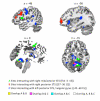T'ain't what you say, it's the way that you say it--left insula and inferior frontal cortex work in interaction with superior temporal regions to control the performance of vocal impersonations
- PMID: 23691984
- PMCID: PMC4050359
- DOI: 10.1162/jocn_a_00427
T'ain't what you say, it's the way that you say it--left insula and inferior frontal cortex work in interaction with superior temporal regions to control the performance of vocal impersonations
Abstract
Historically, the study of human identity perception has focused on faces, but the voice is also central to our expressions and experiences of identity [Belin, P., Fecteau, S., & Bedard, C. Thinking the voice: Neural correlates of voice perception. Trends in Cognitive Sciences, 8, 129-135, 2004]. Our voices are highly flexible and dynamic; talkers speak differently, depending on their health, emotional state, and the social setting, as well as extrinsic factors such as background noise. However, to date, there have been no studies of the neural correlates of identity modulation in speech production. In the current fMRI experiment, we measured the neural activity supporting controlled voice change in adult participants performing spoken impressions. We reveal that deliberate modulation of vocal identity recruits the left anterior insula and inferior frontal gyrus, supporting the planning of novel articulations. Bilateral sites in posterior superior temporal/inferior parietal cortex and a region in right middle/anterior STS showed greater responses during the emulation of specific vocal identities than for impressions of generic accents. Using functional connectivity analyses, we describe roles for these three sites in their interactions with the brain regions supporting speech planning and production. Our findings mark a significant step toward understanding the neural control of vocal identity, with wider implications for the cognitive control of voluntary motor acts.
Figures
References
-
- Ackermann H, Riecker A. The contribution of the insula to motor aspects of speech production: a review and a hypothesis. Brain Lang. 2004;89(2):320–328. doi: 10.1016/S0093-934X(03)00347-X ; pii: S0093934X0300347X. - PubMed
-
- Bailly G. Close shadowing natural versus synthetic speech. International Journal of Speech Technology. 2003;6(1):11–19.
-
- Belin P, Fecteau S, Bedard C. Thinking the voice: neural correlates of voice perception. Trends in Cognitive Sciences. 2004;8(3):129–135. doi: 10.1016/j.tics.2004.01.008. - PubMed
Publication types
MeSH terms
Grants and funding
LinkOut - more resources
Full Text Sources
Other Literature Sources






